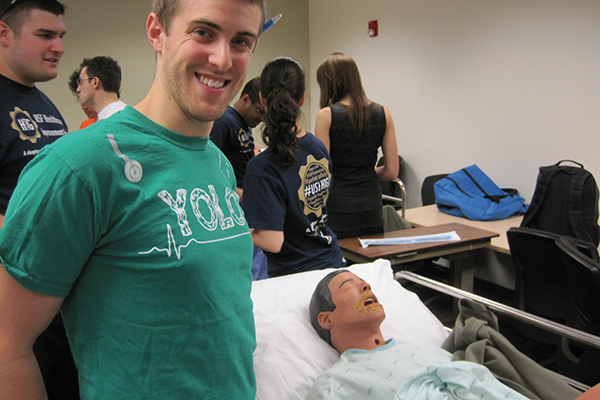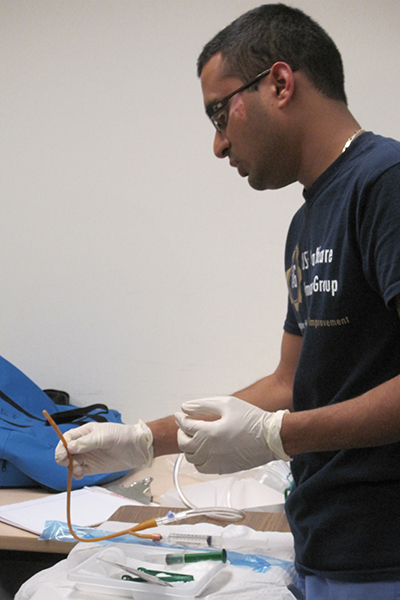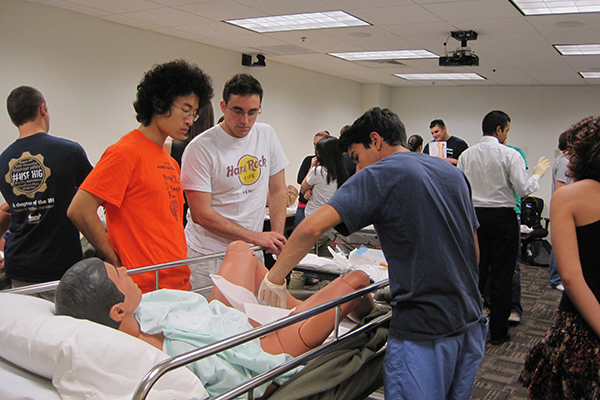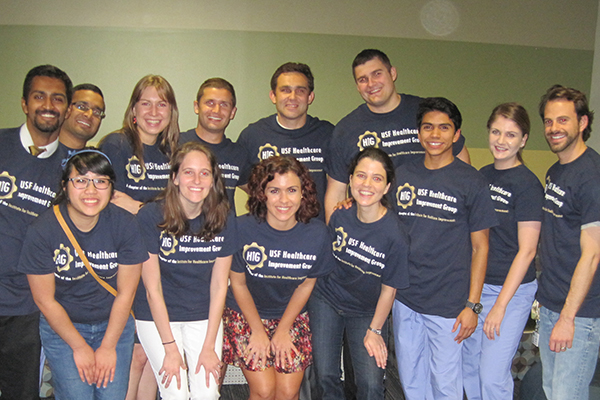Despite countless hours of prevention training for healthcare professionals, urinary tract infections (UTIs) remain a big problem in nearly every hospital in the country.
To help curb, and even reduce, the prevalence of UTIs, USF Health students took the initiative and set up a training session for fellow students to teach on the proper way to insert a Foley catheter.
The aim of the effort: to instill early on a habit of prevention and improved patient safety, prior to entering the hospital workplace.
Attending the Foley catheter training is Peter Silverman, first-year medical student.
The Foley training session, which was held in the USF Health Center for Advanced Clinical Learning last month, is the first of many types of self-training exercises to be hosted by the USF Health Healthcare Improvement Group (HIG), an interprofessional student organization dedicated to developing a culture of healthcare quality improvement and maximizing patient safety.
Established last Spring, the USF HIG is a chapter of the Institute for Healthcare Improvement (IHI) and currently includes students from the USF Colleges of Medicine, Nursing and Public Health. The interdisciplinary group was started primarily to develop a culture of change for improving patient safety and providing training to advance healthcare quality improvement, said Neil Manimala, a first-year medical student and a co-president for the USF HIG along with Anthony Desantis.
“HIG is committed to not only improving patient safety through specific projects but also changing the culture of healthcare to one of true quality improvement and teamwork rather than blame, liability, and total practitioner isolation,” Manimala said.
The USF HIG was founded primarily by Trevor Lewis, along with Jennifer Bruno, Christopher Centonze, Christopher Childs, Melinda Fang, Ian Mark, Keith O’Brien, Alexandra Printz, and Bruna Zanolini, all of whom are now second-year medical students.
Although currently including only medical, nursing and public health students, HIG is looking to include all USF Health professional students, Manimala said.
“We are currently working together with nursing students and public health but would like to expand the scope of our student involvement to the rest of USF Health, as well,” he said.
HIG began as an extension of the Morsani College of Medicine’s scholarly concentration called Health Systems Engineering. Within that, the group connected with the IHI in order to tap into the national group’s online training series called IHI Open School for Health Professions, which includes multiple patient safety training modules. USF students expanded on-site sessions for the modules to include concurrent training sessions with panels of experts, typically USF faculty, who spoke and led team discussions.
The localized focus has helped the group broaden its reach beyond those interested only in the modules and resulting certificate and helped reinforce concepts by seeing real-world applications by invited faculty with interests and experience in patient safety and quality improvement.
Ever-increasing interest in the modules and training sessions has meant looking ahead for the new group.
“We are looking to expand this training facilitation to the Northwestern University Patient Safety Education Program,” Manimala said. “And we hope to one day integrate these patient safety education efforts into the formal health professional student curriculum. Besides these projects, members are constantly brainstorming for new ideas on how to improve the healthcare system.”
The hands-on Foley catheter exercise was just one example of how the group aims to facilitate change.
“At this event, students taught each other how to insert Foley catheters into plastic models and to also brainstorm on how to create procedural checklists,” Manimala said. “This exercise is part of a larger long-term student-led project to educate MS-III’s entering their clerkships on safe and effective Foley catheter insertion to avoid UTIs. And the aim is to offer other types of sessions for different procedures. These types of sessions help us train to become leaders in the area of patient safety and healthcare improvement.”
Prepping for training is Neil Patel (MS1).
Inserting a Foley catheter are, from left, Samson Lu (MS1), Daniel Myers (MS1), Viktor Flores (MS1).
At the first Foley catheter training event were, from left, front row, Melinda Fang (MS2), Jennifer Bruno (MS2), Yilmarie Rosado (MS1), Bruna Zanolini (MS2), Viktor Flores (MS1), Kathryn Dean (MS1), Aaron Block (MS4). Back row, Neil Manimala (MS1), Neil Patel (MS1), Emelia Hammond (fourth-year nursing student), Derek Djavaherian (MS1), Anthony Desantis (MS1), Christopher Centonze (MS2).
Story by Sarah Worth, USF Health Office of Communications
Photos by Neil Manimala, first-year medical student, USF Health Morsani College of Medicine




